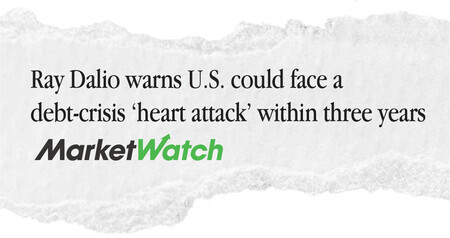
$36,500,000,000,000…
The US national debt has soared past $36 trillion—a number so big a stack of $100 bills would reach more than 24,000 miles high.
And according to the Peterson Foundation:
- $36 trillion is roughly the economic value of China, Japan, Germany, India and the United Kingdom combined…
- The potential tax bill to help cover this debt is now over $247,000 per household or $107,000 per person in America…
- If every US household paid down $1,000/month of that debt, it would take more than 22 years to pay it off…
- Right now, the total amount owed is more than 122% of the GDP (gross domestic product), which is the total value of all the goods and services produced in America each year.
In other words, America isn’t making enough money now nor will it ever be able to pay the government’s debt.
But what does this actually mean for you? And what happens if the debt spiral continues unchecked?
Well, for starters…
This year, the interest payments on the national debt alone will exceed the ENTIRE national defense budget and will be at $952 billion.
That comes down to 2.6 BILLION dollars per day just to cover the cost of borrowing.
And the deeper the debt hole gets, the harder it becomes to climb out of it.
The interest payments are forcing the government to divert funds away from critical government functions like education, healthcare, infrastructure and national security.
The high debt level creates another issue… $3,500 per ounce in 2025 and $4,000 in 2026.
The government is running out of financial “wiggle room” that provides America with a safety net.
In the past, when the economy faced shocks like pandemics, bank failures, or geopolitical crises, Washington could borrow its way through them.
But that spending spree came at a cost:
Because during the COVID-19 pandemic, the government chose to spend and borrow trillions of dollars for disaster relief and economic stimulus checks (when the debt was already at $22 trillion), we are not at a point that when another major crisis hits…
Washington may not be able to afford another massive bailout without raising taxes, printing money, or both.
And if they do, the effects on the economy, the American taxpayer, and the value of the US dollar will be… uncomfortable… to say the least.
But what most American’s don’t realize is that our financial dominance is already eroding.
Foreign investors are losing faith in the US dollar
As you may recall, Fitch, a US credit rating company, downgraded US credit last year, several nations are already dumping their bond holdings, and the BRICS coalition—which includes Russia and China—is moving away from dependence on the US dollar.
And now nine more countries, including Belarus, Cuba, Malaysia, and Thailand, are in line to join BRICS in 2025.
Should foreign creditors lose further confidence in the US government’s ability to repay its debt, they may demand higher interest rates, sell more of their US dollar holdings, or stop lending money to the US altogether.
This eroding confidence plus the international de-dollarization efforts have the potential to trigger a debt crisis where the government faces a sudden spike in borrowing costs or a sharp drop in the dollar’s value. This is the beginning of a debt default scenario as the government is unable to pay its debt.
The government has already come close to defaulting multiple times in recent years around the debt ceiling bickering, and the government will likely face another debt ceiling standoff with Congress in September as the money well starts to run dry… again.
Is there any way to Solve the problem?
Well, the solution is simple in theory, but not easy in practice. Some combination of spending cuts, revenue increases (higher taxes), and deep reforms to entitlement programs like Social Security, Medicare, and Medicaid—which are main drivers of future debt accumulation. All extremely unpopular and the exact opposite of campaign promises.
In addition, this would require a herculean effort of bipartisan support, public support and, ultimately, foreign investor support—all of which are dwindling in the current polarized, politicized environment.
And we may not have the time or resources to achieve it.
Nonetheless, the longer the government waits to act, the more difficult and painful any workable solutions may become.
Because without radical changes, the debt problem grows worse.
This means the year 2025 could be a critical juncture in the government’s financial situation as the economy faces several challenges, including:
- Slowing growth
- Stubborn inflation
- And the escalating trade wars and geopolitical tensions.
Ray Dalio, the founder of the world’s largest hedge fund, warns that mounting US debt problems could lead to “shocking developments.”

“When you reach the part of the cycle that you have to borrow money to pay debt service, and the holders of those bonds say it’s a risky situation—in the private debt market, we call that the debt death spiral,” Dalio said in a Bloomberg interview.
“America is going bankrupt extremely quickly…,” says Elon Musk.
As our unsustainable debt is in dollars, we are dealing with a “dollar problem.”
What’s our government’s track record at fixing problems? Do you believe they can fix our “dollar problem”?
If you answered negatively at both questions, you can have your fortune tied 100% to the success or failure of our government to deal with the problem, or you can protect your savings by having funds in a non-dollar asset like gold and silver that will hedge your wealth. Please don’t hesitate to reach out to us with any questions you may have.
May you be safe and well during these uncertain times.
Paul Stone, CEO
Colonial Metals Group





